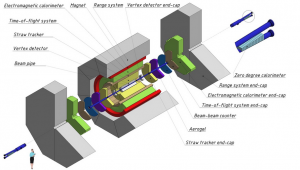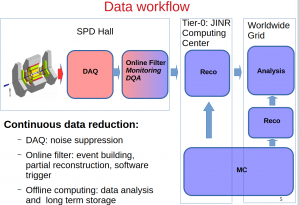T he SPD experiment is aimed at studying the properties of
he SPD experiment is aimed at studying the properties of
strong interactions in the nonperturbative region, at measuring
the proton and deuteron spin structures, and at the development
of a three-dimensional model of the nucleon. It is unique in its
methodology, breadth of coverage and variety of tasks.
SPD – a universal facility for comprehensive study of gluon content in proton
and deuteron at large x
– Prompt photons
– Charmonia
– Open charm
SPD as a data source
● Bunch crossing every 76.3 ns = crossing rate 13 MHz
● ~ 3 MHz event rate (at 1032 cm-2s-1 design luminosity)
● 20 GB/s (or 200 PB/year (rawdata), 3*1013 events/year)
● Selection of physics signal requires momentum and vertex
reconstruction → no simple trigger is possible
The SPD detector is a medium scale setup in size,
but a large scale one in data rate!

For SPD at the CICC EOS data storage system 500.00TB is currently allocated – physical space 1000.00TB.
Resources and services provided by MLIT
• CA, VOMS/IAM, CVMFS
• MICC
• Cloud (IaaS, dedicated VM, spinning disks and SSD)
• CICC (Slurm batch, grid ARC6 CE)
• Govorun HPC, HybriLIT
• Disk and tape storage (EOS =500.00TB is currently allocated – physical space 1000.00TB. , grid SE)
• GitLab, Indico, docdb, video conference, project management, etc.
• Было бы здорово организовать в МЛИТ сервис DBOD (Database On Demand) с поддержкой популярных систем СУБД, например PostgreSQL и MariaDB.
Principles of the computing system
• Jobs -> tasks -> trains of tasks -> workflows
• Files -> datasets
• Gather and keep metadata of each workflow/task/job, dataset/file and event
• Advanced strategies for managing data lifetime: some files to be deleted immediately, other will be kept till the end of the production, another will be stored for some period after being gathered, andthe most important data must be kept forever
• Concentrating on the use of containers as a universal response to the variety of software versions on computing centres: we publish tagged version of SpdRoot at CVMFS so that anyone can use it
• We keep in mind multiprocessor, multithreading and non x86 architectures of the modern hardware
— there is ongoing development of Gaudi based framework for SPD, which will replace SpdRoot, based on ROOT framework
Production setup
• CVMFS as an entry point to the “official” versions of SpdRoot
• Production setups on the CVMFS in form of frozen sandboxes
• Each new production means new directory with all dependencies on CVMFS
• Each production on CVMFS corresponds to path with the same name on
EOS
• Production role in VOMS for users who run mass production
• Directory to store results of the production on EOS with strict access rights in
order not to be deleted accidentally